Here is quick walkthrough from buying a (roughly) 1-year Treasury bond on the secondary market via my Fidelity brokerage account. Please note that I am not a professional bond trader nor a tax professional, and I won’t be able to cover every detail. I maintain part of my portfolio bond allocation in roughly a 5-year bond/CD ladder, comparing and buying the top rate amongst US Treasuries, bank CDs, and credit union certificates across the country as they are all fully-backed by the US government. This guarantees that every year, at least 20% of it is liquid and available in adverse conditions like job loss.
Treasury bonds vs. certificates of deposit. First, you’ll want to compare your Treasury bond effective yield against bank CD rates. At the time of this writing, 1-year Treasury was at ~3.10% while the top brokered 1-year CD was at 3% APY. Due to my local/state tax situation, the after-tax Treasury bond rate was comparable to a 1-year bank CD paying ~3.50%. Right now, the Treasury bond safely wins if held inside a taxable account.
New issue available? For example, if today was 7/15/2022 and I wanted to buy a new 52-week T-Bill from TreasuryDirect or Fidelity, I would look at the official auction schedule see that the next available date for a 52-week T-Bill is on Thursday 8/4/2022 to place an order, 8/9/2022 auction date, and 8/11/2022 settlement date. I have no idea what interest rates will be like then, and for my purposes I wanted to lock in now.
Buying secondary Treasuries on Fidelity. To buy bonds on Fidelity, you must log into your brokerage account and navigate to the “Fixed Income” section, where they will show a quick overview of current rates across roughly 75,000 fixed income investments from brokered CDs to high-yield corporate bonds. (See image at top of post. Click to enlarge.)
Next, click on the “Bonds” tab > US Treasury bonds > Secondary market. This narrows it down to about 578 bond CUSIPs. This search and trade was completed 7/15/2022.
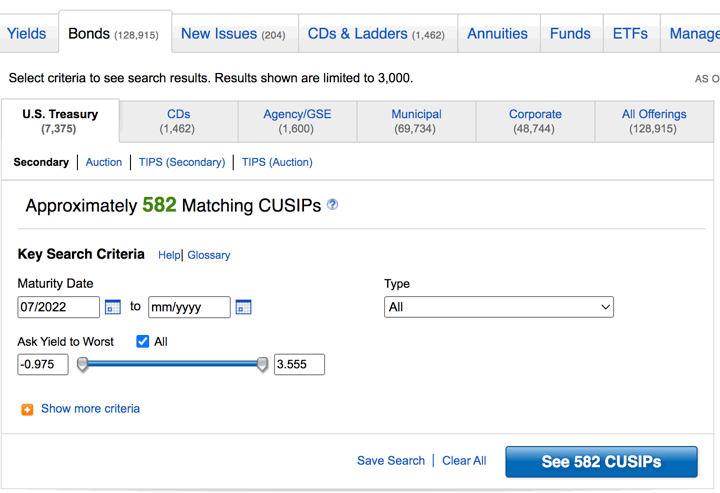
Since I want a Treasury bond with only one year left until maturity, I set the filter for a maturity date between July 2023 and July 2023. That should narrow it down to only 5 bond CUSIPS. Let’s take a look at them (click to enlarge):
These are all “used” bonds that have already been issued and been paying someone else interest at their own rate. The market will adjust the price of these secondary bonds so that everything with a similar maturity ends up paying relatively close to a current “market” rate. Most of these started out paying really low interest rates, so right now you’ll often be buying them at a discount to their face value. (When interest rates go up, prices for existing bond go down since their interest payouts are lower.)
If you hold two bonds with the same “yield to maturity” all the way until it matures and pays you back the principal, you should end up with the same amount of gain at the end even if it is split differently between interest income and capital gain. (If you buy at a discount and have years left until maturity, a pro-rated portion of the discount is reported as income every year until maturity.)
Note that these price quotes are separated into “bid” and “ask”. Bid is what folks are offering to pay, and ask is the price at which folks are offering to sell. There is a spread between them because if there wasn’t, they would have matched up and sold. For example, someone might offer to sell at an effective 3.09% yield, with another offering to buy at 3.14% effective yield.
I’m a small fry, so I just pay attention to the “Ask” and the minimum quantity. Sometimes the offered price looks good but requires you to buy $500,000 of it! (1 bond = $1,000 face value.) Also, the prices are like stocks and fluctuate constantly, so don’t anchor yourself to any specific number. I might wish I could get that 3.20% I saw the day before, but that rate may or may not come back during my buying window.
When you’re ready, you can place a limit order. This lets you set a maximum price you’ll be willing to pay (and thus minimum yield). For example, I chose this Treasury bond that began life as a 5-year bond on 7/31/2018 and matures on 7/31/2023 with an annual coupon of 2.75%. I offered a price of 99.652 each, which guarantees me a minimum effective yield of 3.09% (exempt from state and local taxes). I recommend always using a limit order, just in case.
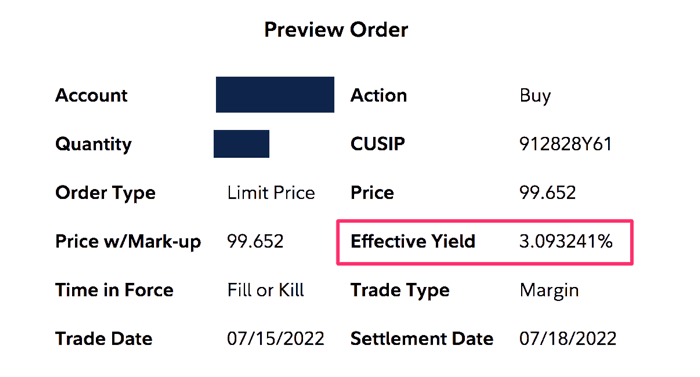
A note on commissions. Fidelity does not charge a commission (or mark-up) on secondary US Treasury bond purchases if performed online. There is still the indirect cost of the bid/ask spread, but that is more of a concern if I was to sell. I believe that Fidelity has close enough to the best order fill available to an individual investor. I haven’t compared them in detail, but be aware that others may charge a mark-up.
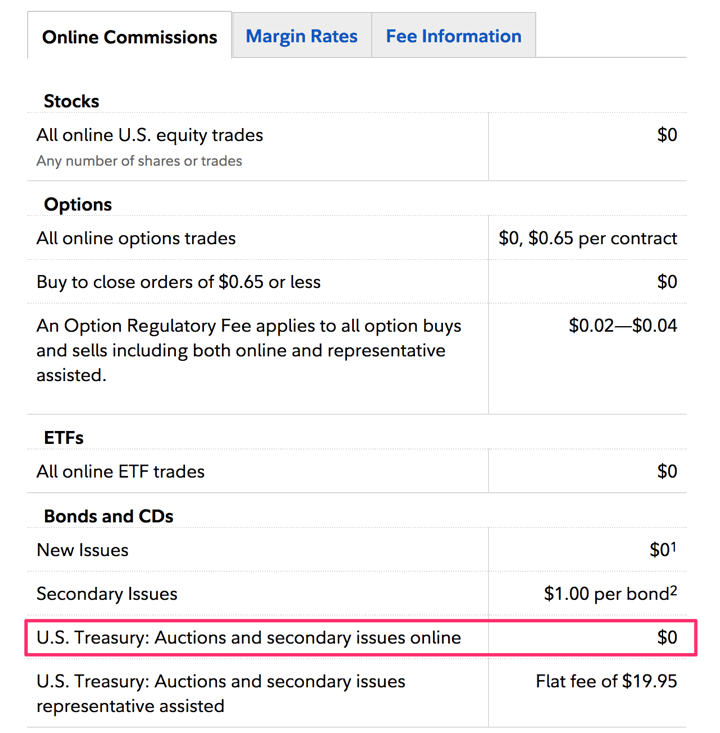
My order was successfully filled at $99.652, which means for 10 bonds with $10,000 face value, I paid $9,965.20 for the bonds plus a little more for any accrued interest. US Treasury bonds are not callable and the interest is paid semi-annually. My next interest payments (at the old bond’s lower 2.75% rate) will be on 7/31/2022, 1/31/2023 and 7/31/2023 with the full return of $10,000 face value at maturity. Again, based on my local/state tax situation, my after-tax interest will be comparable to a 1-year bank CD paying 3.50% APY. This compares well to the best available rates on cash right now.
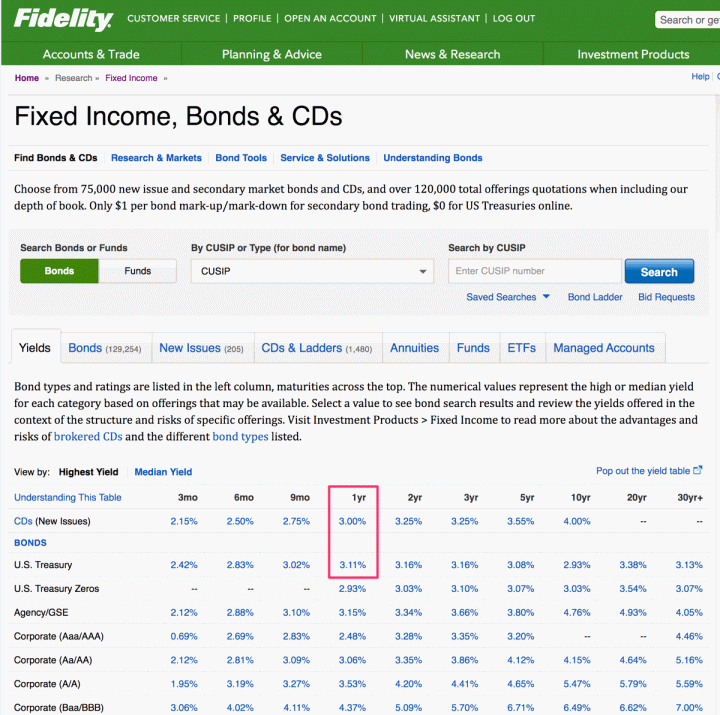
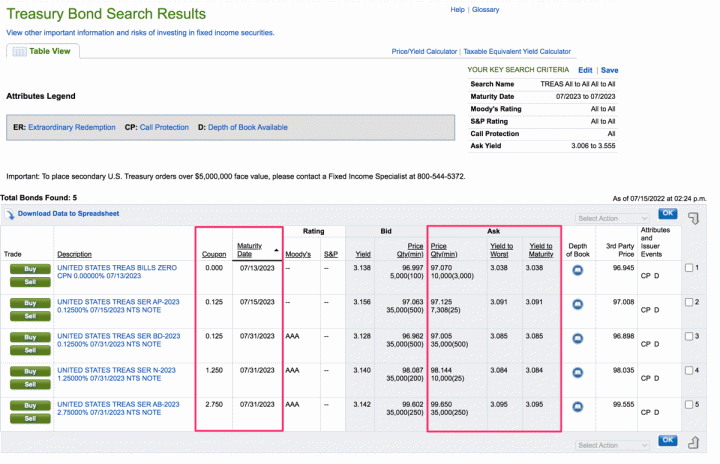
 The Best Credit Card Bonus Offers – 2025
The Best Credit Card Bonus Offers – 2025 Big List of Free Stocks from Brokerage Apps
Big List of Free Stocks from Brokerage Apps Best Interest Rates on Cash - 2025
Best Interest Rates on Cash - 2025 Free Credit Scores x 3 + Free Credit Monitoring
Free Credit Scores x 3 + Free Credit Monitoring Best No Fee 0% APR Balance Transfer Offers
Best No Fee 0% APR Balance Transfer Offers Little-Known Cellular Data Plans That Can Save Big Money
Little-Known Cellular Data Plans That Can Save Big Money How To Haggle Your Cable or Direct TV Bill
How To Haggle Your Cable or Direct TV Bill Big List of Free Consumer Data Reports (Credit, Rent, Work)
Big List of Free Consumer Data Reports (Credit, Rent, Work)
Jonathan, thank you for this well researched and clearly written article. It was very informative and opened my eyes to a new way of buying US treasuries. Kudos to you!
Glad you found it useful!
Hi Jonathan
I have been following your Money Blog for a long time …I found this article very useful.
I tried to follow your step by step guide to buy Treasury Bonds from Fidelity Brokerage. Is there something similar for smaller cash amounts (10k through 25k, for example). When I follow the steps here, it says the min order is 250k size!
Thanks in advance for any insights/information.
Regards!
The minimum ask for a certain yield may be 250 bonds ($250,000 face value), but during open market hours you should be able to find some price (may not be as good as the best price) for as little as 1 bond ($1,000 face value). It’s like Costco, sometimes you get a better price if you buy in bulk.
Just wondering why the initial payment is only $9,965.20 for $10,000 worth of bonds? Is that akin to an initial interest payment? Also, if interest rates continue to rise, I assume Fidelity will show the current value of your bonds being less than you paid for them. However, I assume the current value of held bonds would be irrelevant if you hold the bonds to maturity. Is this correct?
You’re buying an old bond, in this case one that pays 2.75% interest. However, a current $10,000 bond with the same time left pay lets say 3.09%. Why would you buy the old bond if it costs $10,000 as well? 🙂 Therefore, you need to buy the old bond at a discount in order for it to work out to the same gain/profit at maturity. The math works out that you buy the old bond for say $9,965 and even though it only pays 2.75% of $10,000 (which is less than 3.10%), you get $10,000 at maturity.
The difference between the $9965 and the $10,000 makes up for the lower 2.75% interest payouts.
Very helpful. My mistake was that I thought in your example in the post that the bonds you were buying from Fidelity were at a new auction; thus I expected $10k in bonds to cost $10k, not the $9965 you paid. Thanks again.
Jonathan, excellent article. One thing, the other article says $80,000 for AMT. But in 2022 the IRS says $75,900 for single or $118,100 if married. They just recently updated. 9.3 for state/local? 2021 booklet for ca says $4452. That comes to 4.452% if income is $80,000.
I don’t know all the AMT details, but the 9.3% is a marginal tax rate not your overall effective tax rate or total tax paid. Marginal tax rate is the tax paid on your next dollar of earnings, like this bond interest.
Thanks a lot Jonathan. If you pay $9965 for a $10,000 bond in one year’s time you get $310. You receive that over the entire year. The effective tax rate on the $310 is 4.452% in Ca in 2021 if you are in the 9.3 marginal bracket? That seems right?
I’ve compared Fidelity and Vanguard Treasury offerings in the past and found that Vanguard has much better prices due to lower spreads. BTW, you should be concerned about bid/ask spreads when buying OR selling because you pay for the spread with each transaction.
Please elaborate. I have been trying to figure out how much I pay to buy treasuries via a broker vs Treasury Direct to start. Thanks
Would you please also write over how to sell the T bonds? thanks
Thanks a lot Jonathan. If you pay $9965 for a $10,000 bond in the last year of the bond you get $310. $275 for interest and $35 OID. You receive that over the entire life of the bond after you buy it used because the return accrued over that time period. The effective tax rate on the $310 is 5.565 in Ca in 2021 (FTB doesn’t have a tax table for 2022 just yet) – – if you are in the 9.3 marginal bracket based on $80,000 taxable income. But then there is the AMT if you are single because it starts at $75,900 in the year 2022. But if married you don’t have to worry about it until you get to $118,100 in 2022. Hope this helps.
Great article Jonathan. Here is a question lingering in mind after reading your article. With Fed raising rates every quarter and CD rates changing accordingly, how can one commit to either of the investment vehicles? How can one lock-in into a rate, knowing that it will change the next quarter? Thoughts? Also would you share how can one sell these bonds?
Thanks for the info Jonathan. Is the last interest payment made on the day the bond matures? I see that in your article you say that it does. However, when I was looking at some bonds today some of them show the “ next coupon date” and the “ last coupon date” and in some cases the last coupon date is 6 months before the bond matures, meaning it’s only showing one coupon payment.
For example, bond 91282CAK7. A one yr treasury. If you look at the issuer informants under the overview section it shows the next coupon and the last coupon both as 3/15/23 with the bond maturing on 9/15/23. So will you only get one interest payment? Or is the last interest payment paid at maturity? Or do you only get the one payment but the difference is made up in the bond price you paid? Or am I wrong on all accounts? Thanks for any help you can be.
Good question…. “Last coupon date” is a misleading term, because if you look up the definition in Fidelity, it tells you
“Penultimate” means second to last. So your last payment actually comes with your return of principal at maturity.
Meanwhile, look at the definition of maturity:
Hope that helps clear things up. Honestly, I just trust the yield-to-maturity/yield-to-worst feature of my Fidelity bond quotes and let them do the math.
how do you calculate the return? is it the rate of return lower than the Yield we see in the website?
This was really helpful, I have been putting off buying Treasury Bills for a while because I didn’t totally understand how to do this through Fidelity. I appreciate your post!
Glad you found it useful!